
RMS Alcantara was an ocean liner which entered service just weeks before the start of World War I, was converted to an armed merchant cruiser in 1915, and was sunk in combat with the German armed merchant cruiser SMS Greif in the Action of 29 February 1916.

HMS Anchusa was a Flower-class corvette that served in the Royal Navy.

SS Justicia was a British troop ship that was launched in Ireland in 1914 and sunk off County Donegal in 1918. She was designed and launched as the transatlantic liner Statendam, a new flagship for the Holland America Line (NASM), but the outbreak of First World War delayed her completion. In 1915 NASM agreed to let the United Kingdom acquire her and have her completed as a troop ship.

SS Laurentic was a British transatlantic ocean liner that was built in Belfast, Ireland, and launched in 1908. She is an early example of a ship whose propulsion combined reciprocating steam engines with a low-pressure steam turbine. Laurentic was one of a pair of sister ships that were ordered in 1907 by the Dominion Line but completed for the White Star Line. Her regular route was between Liverpool and Quebec City.

SS Minnedosa was one of a pair of transatlantic steam ocean liners that were built in the United Kingdom, launched in 1917 and operated by Canadian Pacific until 1935. Her sister ship was Melita.
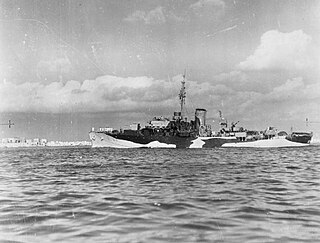
HMS Bryony was a Flower-class corvette that served in the Royal Navy and Royal Norwegian Navy.

The German ship Doggerbank was a UK cargo ship that was built in Scotland in 1926, captured by the German Navy in 1941, renamed Doggerbank and converted into an auxiliary minelayer and blockade runner. The German U-Boot U-43 (1939) sank her by mistake in 1943, leading to the deaths of all but one of her 257 passengers and 108 crew.
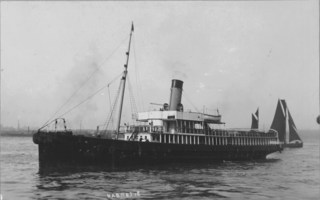
SS Magnetic was a passenger tender of the White Star Line built in 1891. She was laid down at the Harland and Wolff Shipyards in Belfast, Ireland. Magnetic was sold to a different company in 1932 and renamed Ryde, and scrapped in 1935.
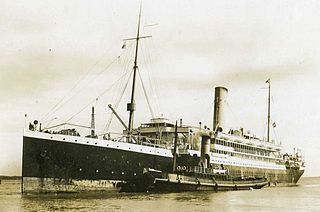
HMT Aragon, originally RMS Aragon, was a 9,588 GRT transatlantic Royal Mail Ship that served as a troop ship in the First World War. She was built in Belfast, Ireland in 1905 and was the first of the Royal Mail Steam Packet Company's fleet of "A-liners" that worked regular routes between Southampton and South American ports including Buenos Aires.

MV Empire Star was a UK refrigerated cargo liner. She was built by Harland and Wolff in 1935 as one of Blue Star Line's Imperial Star-class ships, designed to ship frozen meat from Australia and New Zealand to the United Kingdom. She served in the Second World War and is distinguished for her role in the Evacuation of Singapore in February 1942. She was sunk by torpedo in October 1942 with the loss of 42 lives.

RMS Asturias was a Royal Mail Steam Packet Company ocean liner that was built in Ireland in 1908 and scrapped in Japan in 1933. She was a Royal Mail Ship until 1914, when on the eve of the First World War the British Admiralty requisitioned her as a hospital ship.
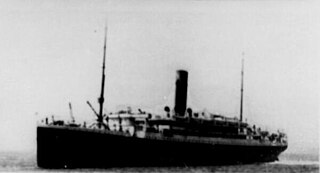
RMS Amazon was a transatlantic Royal Mail Ship that the Royal Mail Steam Packet Company operated on scheduled services between Southampton and South American ports including Buenos Aires. She was the second of the RMSP's fleet of "A" series liners, and was launched in 1906.

SS Russian was a British cargo liner that was launched in Ireland in 1895 as Victorian. In her first few years she carried cattle from Boston to Liverpool. From 1903 she carried cattle from New York to Liverpool. From 1908 she traded between the Gulf Coast of the United States and Liverpool. Leyland Line owned her throughout her career, but White Star Line managed her from 1903. She was renamed Russian in 1914.

SS Ashkhabad was a merchant ship of the Soviet Union sunk in 1942. She had been built as a British merchant ship in 1917 in Glasgow, Scotland as War Hostage. Over the next three decades she passed through a number of owners and had several different names; Milazzo (1919–1924), Aldersgate (1924–1925), Mistley Hall (1925–1934), Kutais (1934–1935), Dneprostroi (1935–1938) and finally Ashkhabad from 1938 to 1942. Originally designed as a freighter, she was at several points converted to a tanker to carry fuel oil. At the time of her loss the four hundred foot tanker was owned by the Soviet Union's Sovtorgflot organisation. She was torpedoed on 29 April 1942, and then sunk as a hazard to navigation on 3 May 1942. The wreck is now a popular dive site.
SS Glenartney was a cargo steamship that was launched in Scotland in 1911 and sunk by a U-boat in the English Channel in 1918.
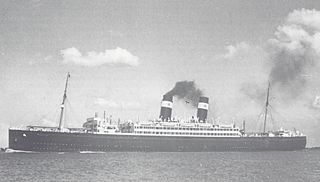
SS Pennland was a transatlantic ocean liner that was launched as Pittsburgh in Ireland in 1920 and renamed Pennland in 1926. She had a succession of UK, German and Dutch owners and operators. In 1940 she was converted into a troopship.

SS Westernland was a transatlantic ocean liner that was launched as Regina in Scotland in 1917, renamed Westernland in 1929 and was scrapped in 1947. She began her career as a troop ship repatriating US troops after the Armistice of 11 November 1918. In the Second World War, Westernland served as a troop ship, repair ship and destroyer depot ship.
SS Sagamore was a transatlantic cargo liner that was built in Ireland in 1892 for George Warren's White Diamond Steam Ship Company. In 1913 she was modified to carry passengers as well as cargo. In 1917 a German U-boat sank her, causing the death of 52 members of her crew.
SS Melita was one of a pair of transatlantic steam ocean liners that were built in the United Kingdom, launched in 1917 and operated by Canadian Pacific until 1935. Her sister ship was Minnedosa.
SS Potaro was a refrigerated cargo steamship that was built in Belfast in 1904, and captured and scuttled in the First World War in 1915.















